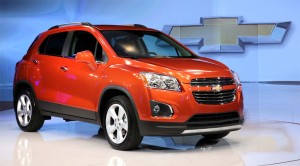
Strong sales of crossovers like the 2015 Chevy Trax helped improve the overall fuel economy rating of new vehicles sold last month.
Despite the continuing surge in trucks sales, which was again evident in January, and falling gasoline prices, the fuel economy of new vehicles purchased by Americans actually improved last month, ending a lengthy drought of stagnation.
Gas mileage of new vehicles, as calculated by the Environmental Protection Agency, sold in the U.S. was up last month for the first time since last August, according to researchers at the University of Michigan Transportation Research Institute.
Average fuel economy, which is based on the window-sticker values of cars, light trucks, vans and sport utility vehicles, purchased in January was 25.4 mpg, up from 25.1 mpg in December. It was still down from August’s all-time high of 25.8 mpg. Overall, vehicle fuel economy is up 5.3 mpg from October 2007, the first full month of monitoring by UMTRI researchers Michael Sivak and Brandon Schoettle.
The improvements in fuel economy undoubtedly reflect the improvements in truck fuel economy that over the last couple of years. The fuel economy of the Chevrolet Silverado, Ram 1500 and now the new Ford F-150, which chalked up big sales numbers in January, have all improved over earlier versions of the pickup trucks thanks to the introduction of small but powerful engines equipped with turbochargers and direct injection technology.
(Women want midlife crisis cars too. For more, Click Here.)
The new crossovers introduced last fall, such as the Lexus NX, Nissan Murano and Chevrolet Trax, are also better on gas than their predecessors, which is helping improve the fuel economy averages.
(Click Here for details on Toyota’s Chicago Auto Show debuts.)
In addition to average fuel economy, University of Michigan Transportation Research Institute also said a monthly update of their national Eco-Driving Index, which estimates the average monthly emissions generated by an individual U.S. driver. The EDI takes into account both the fuel used per distance driven and the amount of driving — the latter relying on data that are published with a two-month lag.
(To get a better look at Kia’s Trail’ster concept coming to Chicago, Click Here.)
After a two-month slide, the EDI improved to a record-tying low of 0.77 in November. The index currently shows emissions of greenhouse gases per driver of newly purchased vehicles are now down 23% since October 2007.
